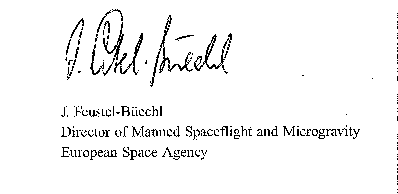
Jörg Feustel-Büechl

The first six articles in this issue of the ESA Bulletin recount the planning, execution and results of the Euromir manned missions. The 31-day Euromir 94 mission and the 179-day Euromir 95 mission were the first large-scale projects of this nature to be conducted by ESA and the European space community in partnership with the Russian Space Agency and Russian industrial entities. They also represented ESA's first steps into long- duration manned missions, as precursor flights for Europe's planned participation in the building and operation of the International Space Station.
Euromir has certainly been a unique experience for those involved in all of its stages, from the early negotiation of the flight opportunities and contracts, through the selection and building of the various experiments, to their timely delivery, installation and successful operation aboard the Russian Mir station.
Just one example of the novel nature of these missions is to be found in the fact that the transport of equipment to, and the return of items from, the Mir station took place in four different ways for Euromir 95: inside the Spektr module which was launched to the Mir station in May 1995; with the astronauts in the Soyuz manned spacecraft; via three supply flights by a Progress unmanned cargo vehicle; and on three docking flights by the US Space Shuttle. Many inventive solutions had to be devised to accomplish the timely handover of items between the many parties involved and to satisfy the various legal, safety and customs requirements associated with the overall transportation logistics.
The experience gained in this and the many other unique aspects of men and women of different nationalities working together routinely in the exploitation of space will undoubtedly be of great value to us and our International Partners in the future cooperative utilisation of the International Space Station.
In the following pages, the Euromir experience is recounted from various points of view by the specialists intimately involved in the preparation and operation of Euromir 94 and Euromir 95. It is my pleasure to acknowledge here the great success of both missions and to thank those involved - the Russian and European Project Teams and all associated personnel at the various control and support centres - for their valuable efforts in preparing and operating these missions. Together with the scientists responsible for the onboard and associated ground experiments, and particularly the Russian cosmonauts and European astronauts who carried out the two missions, they merit our deepest thanks for their perseverance and dedication.


Mr Jean-Marie Luton (front left), ESA's Director General, and Dr
Yuri N. Koptev (second from the right), Director General of the
Russian Space Agency (RKA), at a reception in Moscow to celebrate
the successful completion of the Euromir 95 mission


 ESA Bulletin Nr. 88.
ESA Bulletin Nr. 88.